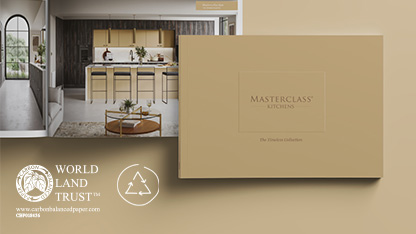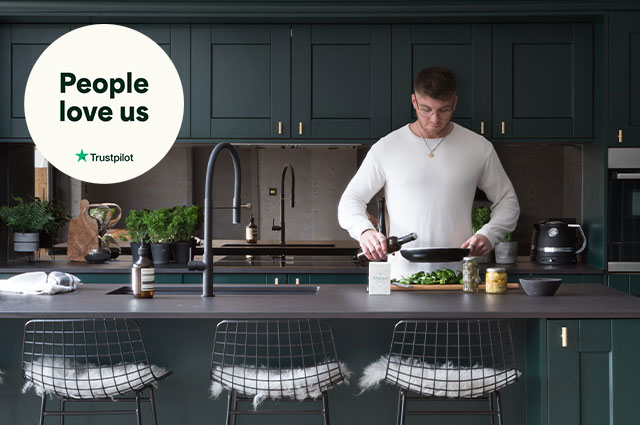Biophilic Design: Create a Natural Kitchen Sanctuary
Tuesday, 5th September 3:25pm 2023
Picture your life – clean, dry, comfortable. Sheltered from the elements, you travel between work and home, never touching greenery. At first, you love your domestic comfort. You never gelled with biophilia, anyway – the love of nature. One day, though, you feel it:
Drumbeats.
At first, you think it’s Jumanji. The movie wasn’t fiction; it was real. But no… Faced with a depressingly adult alternative, you realise it isn’t adventure on the horizon. It’s a hospital stay. That beat is your pulse. High blood pressure. A sign of chronic stress.
“Try biophilic design. Create a natural kitchen,” your GP suggests. “Cool stone, warm wood, waxy leaves on your skin. Nature’s good for your wellbeing.” But is it really? Healthline experts certainly think so. But how does one create a natural kitchen with biophilic architecture?

Embrace Natural Light
To begin, you must first ask, “What is biophilia?” If you’re unfamiliar with the word, “philia” means “love of” and “bio” means “life.” So, designers of biophilic cities, offices and homes embrace the love of nature. And doing so is easy. You just need to work out what’s missing from yours.
Studies suggest that some western populations, for instance, spend 90% of their time indoors, despite a lack of daylight negatively impacting mood and circadian rhythm. Hence, if you want to create a paradise in your kitchen, start with a classic line for inspiration: “Let there be light.”


Say you’re renovating. Why not add a kitchen conservatory area, a small orangery kitchen extension or even just an extra kitchen window to your plans? And if manipulating the walls isn’t an option, how about a kitchen skylight? Each window will add well-needed light and fresh air.
At Masterclass, we maximise homeowners’ natural light exposure, offering chef’s tables, which even fit in shallow window alcoves. Similarly, we provide open shelving and bi-fold cabinet doors to minimise light obstruction. Together, these components perfectly execute biophilic design.
Pro Tip!
Want more design tips and lifestyle advice to help you make the most of your kitchen? Become a Masterclass Insider for free. You’ll get a library of virtual lifestyle guides just for subscribing.
Claim Your Welcome LibraryInclude Natural Wood and Stone
Biophilic design covers more than just light and plants. Indeed, stone and natural wood also play a part. What you’ll find is that a lot of these principles overlap with Scandi concepts like Hygge. It makes sense; cultures are bound to reach similar conclusions when it comes to universal human needs.


Much like with Hygge, natural flagstone flooring and wool rugs will appeal to your biophilia, but so will installing minimally processed features like wood crate drawers, wood-effect drawers and stone-effect worktops. If you do opt for them, dark kitchens provide the perfect backdrop.
Harness House Plants
Undeniably vital, house plants are integral to biophilic design and they’re the easiest component to install, not least on solid oak shelving. Not only do they oxygenate the air, but their presence is proven to cause relaxation in humans in a way that artificial house plants can’t replicate.


Whatever house plants you choose should depend on the style of your kitchen. For example, if you enjoy Japanese design, potted topiary trees and a Japanese peace lily might work. If you have a typical classic kitchen, on the other hand, wall hanging plants might be a better fit.
Biophilic Design Finishing Touches
Once you’ve gotten the basics in place, the only thing left is to add sentient life as a finishing touch. Do you have pets? Fluffy friends are the perfect remedy for those lacking nature in their lives. Not only do they provide companionship but they also encourage us to walk in nature.

At Masterclass, we factor pets into our kitchen designs for clients who love their animals. Many ask us to leave gaps for dog beds and cat perches. The spaces below chef’s tables and in shelving cubby holes work particularly well if you want to optimise a pet-friendly kitchen.
But don’t worry if you’re not a pet person. There are lots of ways to double down on biophilic design. Take rattan mirrors, indoor water features or curved furniture made from sustainable sources, for example. Admittedly, there’s a lot to consider. If you need more help, find your nearest showroom and book a consultation, or become a Masterclass Insider for free. As an Insider, you’ll get exclusive design tips, plus welcome guides and resources.

















